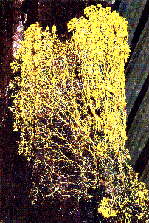Slime Moulds

Photo: C & D Frith
Australian Tropical Rainforest Life
Slime Moulds - Slime moulds belong to the subdivision Plasmodiogymnomycotina II, and the class Myxomycetes.
- Originally, the slime moulds perplexed biologists, as they did not seem to completely fit the classification of either animals or plants, but they shared some characteristics of both groups.
- In structure and physiology they have an animal-like plasmodium (an acellular, creeping somatic phase of the slime mould), but their reproductive structures are fungus-like, producing spores covered by definite cell walls in stationary sporophores.
- They were classed as animals by DeBary (1887), a founder of the science of mycology, and called Mycetozoan. From the Greek language, this translates as mushroom/fungus animal.
- The term was later changed to Myxomycetes (slime mushroom/fungi).
- Because they are a relatively old and stable group, they have become specialised in several ways. They departed sufficiently from the main evolutionary line of fungi to constitute a subdivision of their own.
- Slime moulds usually live in cool, shady, moist places in the woods, on decaying logs, dead leaves, or other organic matter that holds abundant moisture. There are some species that occur in open spaces, creeping over vegetation, and these are particularly conspicuous on the grass of city lawns. Other species may develop on plant debris, animal droppings and pieces of bark taken from living trees and placed in a moist chamber for a few days.
- The most important factors governing the distribution and abundance of slime moulds are probably moisture and temperature. Not all species may be found at all times in the year.
- The majority of the 450 or so known species are universally distributed, but there are some confined to temperate regions, tropics, or alpine areas.
- In general, slime moulds are of little direct economic importance. They feed on bacteria, protozoa and other minute organisms.
- The slime mould Physarum, common in North America, is used extensively as a research tool in the McArdle Laboratory for Cancer Research, University of Wisconsin.
|
